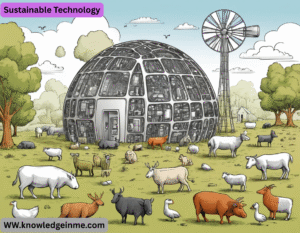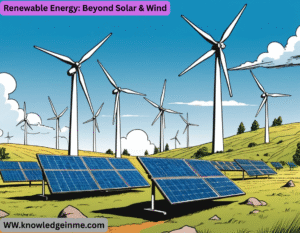Sustainable Technology refers to innovations designed to address environmental, social, and economic challenges while minimizing negative impacts on the planet. These technologies aim to conserve resources, reduce pollution, and promote long-term ecological balance.
Key Areas of Sustainable Technology
Renewable Energy
- Solar, wind, hydro, and geothermal power reduce reliance on fossil fuels.
- Advances in energy storage (e.g., lithium-ion batteries, solid-state batteries).
Energy Efficiency
- Smart grids, LED lighting, and energy-efficient appliances.
- Green buildings with passive design and smart HVAC systems.
Circular Economy & Waste Reduction
- Recycling tech (e.g., AI-powered waste sorting).
- Biodegradable materials and upcycling innovations.
Clean Transportation
- Electric vehicles (EVs) and hydrogen fuel cells.
- Sustainable aviation fuels (SAFs) and public transit optimization.
Water & Agriculture Tech
- Precision farming, drip irrigation, and vertical farming.
- Water purification systems (e.g., solar desalination).
Carbon Capture & Storage (CCS)
- Direct air capture (DAC) and bioenergy with carbon capture (BECCS).
- Green Computing & AI
- Energy-efficient data centers.
- AI for optimizing energy use in industries.
Renewable Energy: Beyond Solar & Wind
Next-Gen Solar:
- Bifacial panels that capture sunlight on both sides.
- Agrivoltaics (combining solar farms with agriculture).
Offshore Wind Innovations:
- Floating wind turbines for deep-water sites.
- Kite-based wind energy (Airborne Wind Energy Systems).
Emerging Renewables:
- Tidal & wave energy (e.g., Orbital Marine’s tidal turbines).
- Algae biofuel for carbon-neutral energy.
- Challenge: Intermittency issues require better grid integration and storage.
Energy Storage Breakthroughs
- Solid-state batteries (higher density, safer than lithium-ion).
- Flow batteries (scalable for grid storage, using liquid electrolytes).
- Gravity storage (e.g., Energy Vault’s concrete-block systems).
- Thermal storage (molten salt or phase-change materials).
- Future Trend: Sodium-ion batteries for cheaper, resource-abundant storage.
Circular Economy Tech
Advanced Recycling:
- Chemical recycling breaks plastics into raw materials (e.g., Pyrolysis).
- Enzymatic recycling for textiles (e.g., breaking down polyester with enzymes).
Biomaterials:
- Mycelium-based packaging (replaces Styrofoam).
- Algae-based bioplastics (fully compostable).
Product-as-a-Service (PaaS):
- Companies like Philips lease lighting, reclaiming materials post-use.
- Challenge: Scaling up recycling infrastructure and combating “wishcycling.”
Carbon Removal Technologies
Direct Air Capture (DAC):
- Low-energy DAC using MOFs (metal-organic frameworks).
Nature-Based Solutions:
- Biochar (carbon-rich charcoal from biomass).
- Ocean alkalinity enhancement (speeding up CO₂ absorption).
Industrial CCS:
- Carbon Cure injects CO₂ into concrete, strengthening it.
Smart Cities & Green Infrastructure
IoT for Sustainability:
- Smart meters + AI to optimize energy/water use.
- Dynamic streetlights that dim when no one’s around.
Green Urban Design:
- Sponge cities (China’s flood-resistant urban planning).
- Cool roofs (reflective coatings to reduce AC demand).
Mobility Innovations:
- Vehicle-to-grid (V2G) tech lets EVs supply power back to the grid.
- Autonomous electric shuttles reducing traffic congestion.
- Challenge: High upfront costs and data privacy concerns.
Food & Ag Tech for Sustainability
Precision Agriculture:
- Drones + sensors monitor soil health, reducing water/fertilizer use.
- AI-powered pest control (e.g., Trap view’s smart traps).
Alternative Proteins:
- Lab-grown meat (e.g., UPSIDE Foods).
- Fermentation-based proteins (e.g., Quorn’s mycoprotein).
Regenerative Farming:
- Carbon-sequestering practices like no-till farming.
- Future Trend: CRISPR-edited crops for drought resistance.
Green Hydrogen & Industrial Decarbonization
Uses of Green Hydrogen (H₂):
- Steel production (replacing coking coal with H₂).
- Long-haul shipping and aviation fuel.
Electrolysis Innovations:
- Anion Exchange Membrane (AEM) electrolyzers (cheaper than PEM).
- Solar-to-hydrogen tech (photoel ectrochemical cells).
- Challenge: High energy needs; requires surplus renewable power.
Sustainable AI & Computing
Energy-Efficient AI:
- Tiny ML (machine learning for low-power edge devices).
- Quantum computing for optimizing energy grids.
Green Data Centers:
- Liquid cooling systems (e.g., Microsoft’s underwater data centers).
- Heat reuse (warming nearby buildings).
- Future Trend: AI to predict and prevent e-waste.
Cutting Edge Renewable Energy Frontiers
Space-Based Solar Power (SBSP)
- How it works: Orbiting satellites collect sunlight 24/7, beam energy to Earth via microwaves or lasers.
- Hurdles: Launch costs, energy loss during transmission, and potential ecological effects of microwave beams.
Nuclear Fusion Updates
- 2023 Milestone: Lawrence Livermore’s NIF achieved net energy gain (3.15 MJ output vs. 2.05 MJ input).
- Private Sector: Helion (backed by Sam Altman) aims for net electricity by 2028 using pulsed magnetic fusion.
- Wildcard: Lattice confinement fusion (NASA’s low-energy nuclear reactions).
Hyper Localized Energy Systems
Microgrids for Resilience
- Case Study: Brooklyn Microgrid uses blockchain for peer-to-peer solar trading.
- Global South: Pay-as-you-go solar kits (e.g., M-KOPA in Africa) bypass grid infrastructure.
Human-Powered Energy
- Piezoelectric floors (London’s Heathrow Airport harnesses foot traffic).
- Blood-powered fuel cells (experimental medical implants using glucose).
Waste to-X Innovations
Plastic-to-Fuel Pyrolysis
- Controversy: Critics argue it enables “false recycling” by creating fossil fuels.
- Startups: Agilyx turns polystyrene back into styrene monomer.
Waste Mining
- Urban mining robots (Apple’s Daisy disassembles 200 iPhones/hour to recover cobalt, gold).
- Bioleaching: Using bacteria to extract rare earth metals from old electronics.
Radical Carbon Tech
Enhanced Weathering
- Idea: Spread crushed olivine on beaches to accelerate CO₂ absorption.
- Project Vesta’s pilot in the Caribbean shows promise but risks altering ocean PH.
Artificial Photosynthesis
- Harvard’s “Bionic Leaf 2.0” converts sunlight + water into liquid fuel (efficiency: 10% vs. plants’ 1%).
Transportation’s Next Wave
Ammonia-Powered Ships
- Why? Zero-carbon fuel, easier to store than hydrogen.
- Maersk’s 2024 test vessel could decarbonize global shipping.
Electric Aviation
- Beta Technologies’ ALIA EVTOL (250-mile range, FAA-certified by 2026).
- Hydrogen planes: Universal Hydrogen’s retrofitted regional aircraft.
Controversial Plan B Tech
Solar Geoengineering
- Stratospheric aerosol injection (Harvard’s SCOPEX delayed over ethics concerns).
- Marine cloud brightening (Australia’s Great Barrier Reef trials).
Synthetic Biology Risks
- Carbon-eating bacteria (Lanza Tech’s engineered microbes) could disrupt ecosystems if released.
Overlooked Low Tech Solutions
Passive Cooling
- Ancient tech revived: Iranian “yakhchāl” ice houses inspire modern zero-energy cooling.
- Subsoil air tunnels (e.g., Nottingham University’s geothermal ventilation).
MYCORE mediation
- Oyster mushrooms clean oil spills (used post-Deepwater Horizon).
Geopolitical Battlegrounds
- Rare Earth Metals: China controls 90% of refining; Europe invests in seabed mining (ecological risks?).
- Hydrogen Race: Middle East (green H₂ from deserts) vs. Australia (coal gasification + CCS).
Unsolved Grand Challenges
- Concrete’s Carbon Problem: 8% of global emissions. Solutions like Carbicrete (CO₂-cured) remain niche.
- Aviation’s Fuel Dilemma: SAFs cost 3× more; hydrogen has storage issues.
- Battery Recycling: <5% of lithium-ion batteries are recycled properly today.
Speculative Future (2030–2050)
- Self-Healing Materials: Microcapsules in asphalt or plastics repair cracks.
- Programmable Matter: AI-designed materials that change properties on demand.
- Atmospheric Water Harvesters: MIT’s MOF-based system works in deserts.
Quantum Dot Solar Cells
- Breakthrough: Nanocrystals that absorb UV + infrared (potential 70% efficiency vs. 22% for silicon).
- Catch: Cadmium toxicity; new selenium-based dots may solve this.
Nuclear ’s New Wave
Microreactors (1-20MW):
- Nu Scale’s VOYGR (first US-approved small modular reactor).
- Radiant ’s portable nukes for disaster zones.
Thorium Molten Salt Reactors:
- China’s TMSR-LF1 prototype (2023) runs on nuclear waste.
Ambient Energy Harvesting
- Dirt Batteries: Northwestern’s soil-powered sensors (0.2V/m²).
- WIFI Scavenging: MIT’s rectenna converts radio waves to DC power.




